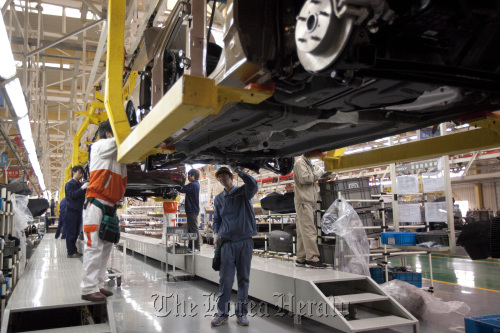 |
Employees work at Geely Automobile Holdings Ltd.’s factory in Cixi, Zhejiang Province, China. (Bloomberg) |
SHANGHAI (AP) ― Chinese manufacturing gained momentum for a fourth straight month in March, helped by a recovery in the auto, tobacco and electronics sectors, though analysts said conflicting data suggest lingering weakness.
The state-affiliated China Federation of Logistics and Purchasing said Sunday that its purchasing managers index, or PMI, rose 2.1 points to 53.1 in March, up from February’s 51.0 and January’s 50.5. A reading above 50 signifies expansion.
The rise in new factory orders suggests a recovery in some industries, though federation analyst Zhang Liqun said there were still worrying signs of weakness in exports, investment and consumer demand.
That was evident in a second set of data, from HSBC, which said that after adjusting for seasonal factors, its PMI index for China for March was 48.3, down from 49.6. HSBC’S index, which tends to reflect trends in the export sector more strongly than the official index, has remained below 50 for five straight months, and recorded its lowest average reading in three years in the first quarter, HSBC said.
The data “confirm a further slowdown of growth momentum, weighed on by weakening new export orders,” said HSBC economist Hongbin Qu.
But he said he expected that further efforts to stimulate the economy through tax breaks, government spending and eased credit would help the economy to rebound in the second half of the year after “bottoming out” in the April-June quarter.
China often sees an uptick in manufacturing and construction in the spring, following the annual Lunar New Year holidays and a national legislative session in March.
“So it is important not to view this as a sign of out-and-out strength,” IHS Global Insight’s Alistair Thornton said in an analysis Sunday. “Nonetheless, de facto credit easing has clearly buoyed sentiment and should lay the foundation for a better second half. At the very least, things are not getting worse.”
Thornton said there was no reason to expect a “v-shaped” recovery this year, given weakness in various industries.
The government data released Sunday showed signs of contraction in the textiles, specialized equipment manufacturing and ferrous metals industries.
China faces a challenge in keeping growth from stalling while avoiding an inflationary rebound, especially given recent surges in oil prices.
China’s economic growth declined to 8.9 percent in the final quarter of last year after Beijing hiked interest rates and tightened other controls to cool inflation. Chinese leaders reversed course in December and promised more bank lending to help companies cope with the slump in global demand, but changes have been gradual.








